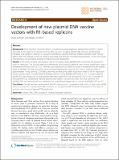| dc.contributor.author | Bower, Diana Morgan | |
| dc.contributor.author | Prather, Kristala L. Jones | |
| dc.date.accessioned | 2012-11-15T18:57:57Z | |
| dc.date.available | 2012-11-15T18:57:57Z | |
| dc.date.issued | 2012-08 | |
| dc.date.submitted | 2012-07 | |
| dc.identifier.issn | 1475-2859 | |
| dc.identifier.uri | http://hdl.handle.net/1721.1/74653 | |
| dc.description.abstract | Background:
There has been renewed interest in biopharmaceuticals based on plasmid DNA (pDNA) in recent years due to the approval of several veterinary DNA vaccines, on-going clinical trials of human pDNA-based therapies, and significant advances in adjuvants and delivery vehicles that have helped overcome earlier efficacy deficits. With this interest comes the need for high-yield, cost-effective manufacturing processes. To this end, vector engineering is one promising strategy to improve plasmid production.
Results:
In this work, we have constructed a new DNA vaccine vector, pDMB02-GFP, containing the runaway R1 origin of replication. The runaway replication phenotype should result in plasmid copy number amplification after a temperature shift from 30°C to 42°C. However, using Escherichia coli DH5α as a host, we observed that the highest yields of pDMB02-GFP were achieved during constant-temperature culture at 30°C, with a maximum yield of approximately 19 mg pDNA/g DCW being observed. By measuring mRNA and protein levels of the R1 replication initiator protein, RepA, we determined that RepA may be limiting pDMB02-GFP yield at 42°C. A mutant plasmid, pDMB-ATG, was constructed by changing the repA start codon from the sub-optimal GTG to ATG. In cultures of DH5α[pDMB-ATG], temperature-induced plasmid amplification was more dramatic than that observed with pDMB02-GFP, and RepA protein was detectable for several hours longer than in cultures of pDMB02-GFP at 42°C.
Conclusions:
Overall, we have demonstrated that R1-based plasmids can produce high yields of high-quality pDNA without the need for a temperature shift, and have laid the groundwork for further investigation of this class of vectors in the context of plasmid DNA production. | en_US |
| dc.description.sponsorship | MIT-Portugal Program | en_US |
| dc.description.sponsorship | Pfizer Inc. | en_US |
| dc.publisher | BioMed Central Ltd | en_US |
| dc.relation.isversionof | http://dx.doi.org/10.1186/1475-2859-11-107 | en_US |
| dc.rights | Creative Commons Attribution | en_US |
| dc.rights.uri | http://creativecommons.org/licenses/by/2.0 | en_US |
| dc.source | BioMed Central Ltd | en_US |
| dc.title | Development of new plasmid DNA vaccine vectors with R1-based replicons | en_US |
| dc.type | Article | en_US |
| dc.identifier.citation | Bower, Diana M, and Kristala LJ Prather. “Development of New Plasmid DNA Vaccine Vectors with R1-based Replicons.” Microbial Cell Factories 11.1 (2012): 107. | en_US |
| dc.contributor.department | Massachusetts Institute of Technology. Department of Chemical Engineering | en_US |
| dc.contributor.mitauthor | Bower, Diana Morgan | |
| dc.contributor.mitauthor | Prather, Kristala L. Jones | |
| dc.relation.journal | Microbial Cell Factories | en_US |
| dc.eprint.version | Final published version | en_US |
| dc.type.uri | http://purl.org/eprint/type/JournalArticle | en_US |
| eprint.status | http://purl.org/eprint/status/PeerReviewed | en_US |
| dc.date.updated | 2012-11-12T20:03:00Z | |
| dc.language.rfc3066 | en | |
| dc.rights.holder | Diana M Bower et al.; licensee BioMed Central Ltd. | |
| dspace.orderedauthors | Bower, Diana M; Prather, Kristala LJ | en |
| dc.identifier.orcid | https://orcid.org/0000-0003-0437-3157 | |
| mit.license | PUBLISHER_CC | en_US |
| mit.metadata.status | Complete | |
